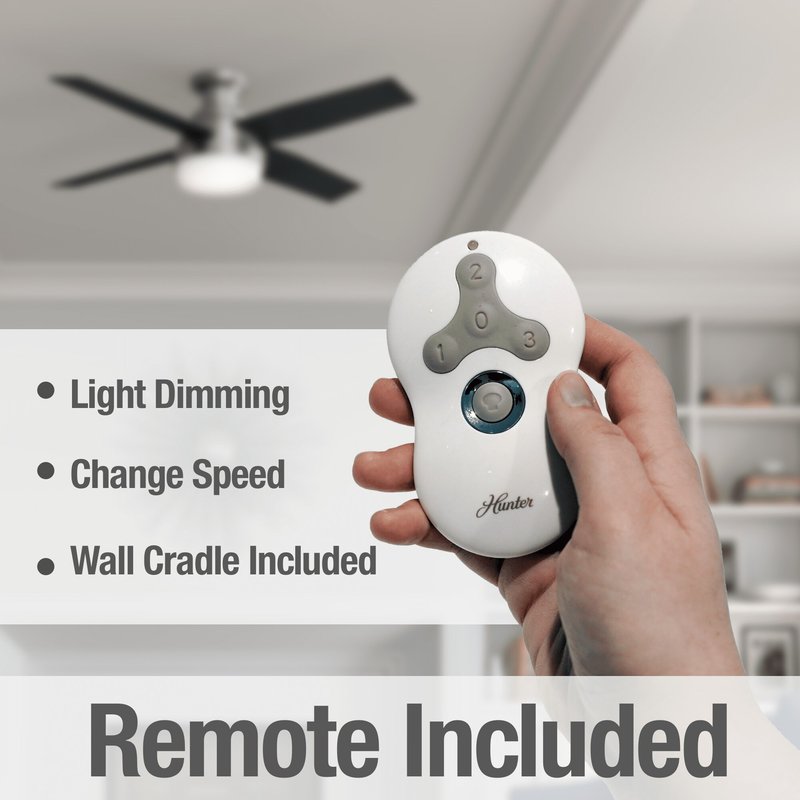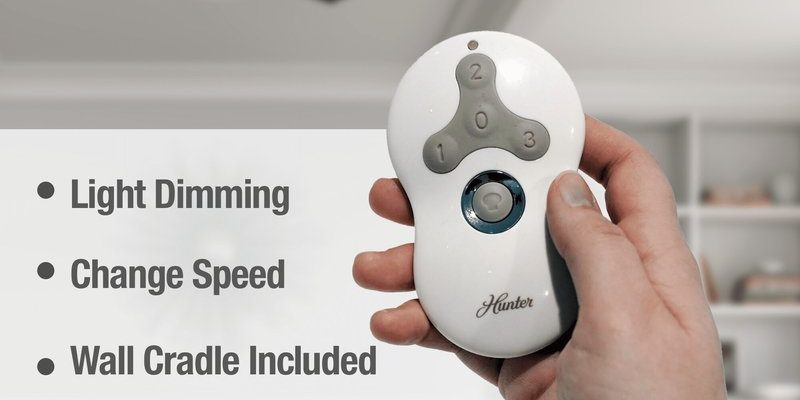
Hunter is a big name in ceiling fans and their remotes are everywhere—small, plastic, often hiding in your couch cushions. These remotes let you control your fan’s speed and light from across the room, changing the whole “get out of bed to turn off the light” dynamic. But when you replace those old incandescent bulbs with modern LED bulbs, suddenly you might notice flickering, dimming that doesn’t quite work, or even lights that just won’t turn on. So, can your Hunter ceiling fan remote really work with LED bulbs? Let’s untangle what’s happening behind the scenes, and sort out what works, what doesn’t, and how you can fix it if things go sideways.
How Hunter Ceiling Fan Remotes Control Light Bulbs
So, first off, what’s actually happening when you press a button on your Hunter ceiling fan remote? Inside your fan, there’s a small receiver that listens for wireless signals from the remote. When you push the light button, the receiver sends power to the bulb socket—easy, right? Not always.
Here’s the thing: traditional bulbs (think incandescent or CFL) aren’t picky. They just want power—any power. But LED bulbs are more sensitive to the way electricity is delivered. Some ceiling fan remotes—especially ones with dimming features—change the type of power sent to the bulb, using a method that worked perfectly fine for old bulbs but makes LEDs flicker or act weird.
If your Hunter remote simply toggles the light on and off, you’re usually in the clear. But if it dims, pulses, or has fancy modes, the remote’s code and the receiver’s “language” might not be fully compatible with your new LED bulbs. Imagine trying to teach your dog a new trick by whistling in a different pitch—it’s the same concept. The tech has to be able to “understand” each other.
Common Problems When Using LEDs With Hunter Fan Remotes
Let me explain why you might run into trouble after switching to LEDs. The most common issues are:
- Flickering: The lights blink or don’t stay steadily lit.
- Dimming issues: You try to dim the LEDs, but they only flicker, or won’t dim at all.
- Lights won’t turn on: Sometimes, nothing happens when you press the button.
Here’s where the remote’s code and the LED’s internal circuitry clash. Many Hunter fan remotes use trailing edge dimming technology, which is compatible with most modern LEDs—if you buy dimmable ones. But some older remotes use leading edge dimming, which just doesn’t play well with LED bulbs.
Sometimes, even if you reset the system or try to pair everything again, the result is the same: flicker city, or no light at all. This isn’t your fault—honestly, most folks aren’t told about this before buying LEDs at the hardware store.
Why Do Some Hunter Remotes Work With LED Bulbs and Others Don’t?
If you’re scratching your head thinking, “Well, my neighbor’s fan uses a remote and their LEDs work fine!” you’re not alone. It comes down to the type of remote and receiver combination you have, plus the brand and model of LED bulb.
Hunter has released many fan models over the years, with different types of remotes and receivers. The newer models are generally more compatible with LED technology, but older remotes can be hit-or-miss. Some allow code changes for different frequencies or pairs, but that’s not usually related to bulb compatibility.
A big factor is whether your remote has dimming control. Non-dimming remotes (those that just turn the light on and off) usually work perfectly with any LED. The trouble starts when the remote tries to dim a bulb that doesn’t support dimming, or the dimmer circuit isn’t designed for LEDs. So if you bought regular, non-dimmable LEDs, or if your Hunter remote was built for older bulbs, things might not line up.
Some users even try to troubleshoot by replacing the battery in their Hunter remote, re-syncing, or tweaking the settings, but unless the circuit itself is compatible, you’ll keep running into issues.
The Importance of Using Dimmable LED Bulbs in Ceiling Fans
Here’s the secret sauce: if you want to use LED bulbs with your Hunter ceiling fan remote—especially if it has dimming features—always pick dimmable LEDs. Not all LED bulbs are dimmable, and the ones that aren’t can react badly if the electrical current isn’t just right.
Dimmable LEDs have special electronics inside that let them handle the variable voltage from a remote-controlled dimmer. Regular LEDs, on the other hand, expect a standard, constant flow of electricity. Put a non-dimmable LED in a dimmer socket and you’ll likely see blinking, buzzing, or bulbs that flat-out refuse to turn on. That’s frustrating, but it’s also exactly what you’d expect if you ask two people to dance and only one knows the moves.
When in doubt, check the packaging on your bulbs. If it doesn’t specifically say “dimmable,” assume it’s not. And yes, dimmable bulbs usually cost a bit more, but you’ll save yourself a lot of headaches (and wild flickering light shows) in the long run.
How to Sync Hunter Remote With LED Bulbs and Troubleshoot Issues
Switching to LED bulbs and running into issues? Here’s a step-by-step guide to help you troubleshoot and get your Hunter ceiling fan remote and LED bulbs working together:
- Step 1: Double-check that you’re using dimmable LEDs, especially if your remote controls brightness.
- Step 2: Replace the battery in your remote, just in case weak power is causing erratic signals.
- Step 3: Try a reset or re-pair of the remote and receiver. For most Hunter remotes, hold down the light and fan buttons together for ten seconds, or follow the instructions that came with your fan.
- Step 4: Plug in one LED bulb at a time. This helps identify if a single bulb is the problem.
- Step 5: If you still see flickering or no light, try a different brand of dimmable LED bulb. Some brands just work better with Hunter remotes, based on how their electronics are designed.
Honestly, sometimes it takes a bit of trial and error. I’ve seen people go through three brands of bulbs before finding one that works smoothly with their setup. It’s not always logical—sometimes the remote, receiver, and bulb just need to “like each other.”
Comparing Hunter Ceiling Fan Remotes With Universal Remotes for LEDs
You might be wondering: should I swap out my Hunter remote for a “universal” ceiling fan remote instead, to get better compatibility with LEDs? There are pros and cons.
Universal remotes are designed to work with a wide range of fans and often advertise LED compatibility. They might have updated dimmer circuits or better code options for pairing. In some cases, installing a universal receiver in your ceiling fan can solve dimming or flickering problems instantly, especially if your existing Hunter receiver is ancient.
But—there’s always a but—using a non-Hunter remote means you lose the guarantee of full feature control. Some functions might not work as smoothly (think: reverse, speed memory), and you might have to tinker with wiring or battery replacement more often. My take? If you’re happy with your Hunter setup and only need to fix the bulb compatibility, try better bulbs first. Only consider swapping remotes if troubleshooting doesn’t help.
Tips for Selecting the Best LED Bulbs for Hunter Ceiling Fans
All LED bulbs look similar, but for use with ceiling fans (and especially with remotes), some choices are better than others. Here’s what I recommend:
- Look for bulbs specifically labeled as dimmable.
- Choose bulbs from reputable brands—these are more likely to list compatibility with ceiling fans and remotes.
- Pay attention to bulb size and heat output. Hunter fans often use compact bulb sockets (like candelabra E12 or intermediate E17 bases).
- If your Hunter fan manual suggests a maximum bulb wattage, stay below this limit—even though LEDs use less power, it’s about safety and fit.
Some LED brands put “fan rated” or “for use in enclosed fixtures” on the box. If you see that, it’s a good sign. Don’t overthink it—just buy a small pack, test them, and see if your remote works as expected.
What to Do If Your Hunter Remote Still Won’t Work With LEDs
If you’ve tried new dimmable bulbs, swapped the battery, and even tried a universal receiver, but nothing’s working, it might be time to dig a bit deeper. Occasionally, the fan’s built-in receiver just isn’t designed for modern LED loads. Older fans (especially those more than 10-15 years old) are the biggest culprits.
In this case, you could:
- Replace the receiver inside the fan with a newer, LED-compatible model (Hunter sells these, or you can use a universal one).
- Wire the fan to a wall switch instead, if you aren’t attached to remote control.
- As a last resort, stick to incandescent bulbs (not ideal, but a short-term fix).
The real root of the problem is matching the remote’s dimming technology with the bulb’s internal circuit. If the two don’t match, you’ll keep having issues—no matter how many times you try to reset, pair, or switch batteries.
Final Thoughts: Getting Hunter Remotes and LED Bulbs to Work Together
Switching from old bulbs to LEDs feels like an upgrade, but if your Hunter ceiling fan remote gets cranky, don’t panic. Most of the time, the solution is simple: use dimmable LED bulbs, check your remote’s battery, and be sure your fan’s receiver is fairly modern. Sometimes it takes a little patience—and maybe a quick trip to the store for the right bulbs—but it’s rare that you can’t get things working.
If everything aligns, your Hunter ceiling fan remote and your shiny new LED bulbs will get along just fine, letting you enjoy easy, energy-efficient lighting and that sweet, lazy remote control convenience. If you hit a snag, troubleshooting step by step almost always gets results. And hey, even if it feels a bit technical in the moment, you’ll end up with a smarter, more efficient home—and one less excuse to NOT get out of bed when the remote inevitably disappears again.
